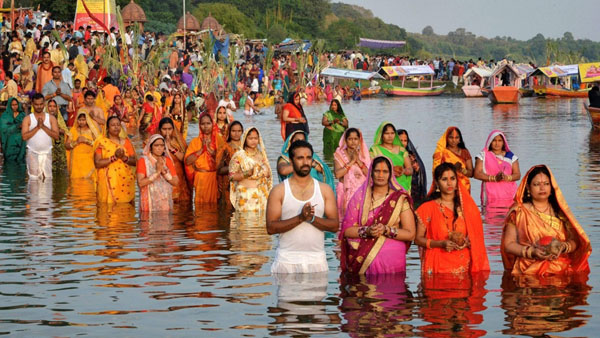By Dipak Kurmi
In the vast tapestry of Indian religious observances, few festivals embody the profound connection between humanity and nature’s celestial forces as magnificently as Chhath Puja. This ancient Vedic festival, predominantly celebrated across the northern and eastern regions of the Indian subcontinent, stands as a testament to the enduring reverence for Surya, the Sun God, and Chhathi Maiya, the sixth form of Goddess Prakriti. Unlike many contemporary religious celebrations that have evolved with elaborate temple rituals and priestly mediation, Chhath Puja retains its pristine authenticity, requiring devotees to engage directly with the divine forces of nature through rigorous austerity, unwavering devotion, and absolute purity of body and mind.
The origins of Chhath Puja stretch back into the mists of antiquity, finding mention in various sacred Hindu scriptures including the Rigveda, where hymns dedicated to the Sun God illuminate the spiritual significance of solar worship. Mythological narratives attribute the genesis of this festival to several legendary figures from Indian epics. One particularly compelling account associates Chhath Puja with Draupadi and the Pandavas from the Mahabharata, suggesting that they performed this worship to regain their lost kingdom and overcome seemingly insurmountable obstacles. Another tradition credits Karna, the tragic hero and son of Surya, as the primordial practitioner of this ritual, performing his daily ablutions and prayers to his celestial father in the flowing waters of rivers. The Ramayana also finds its place in Chhath’s mythological heritage, with some scholars believing that Lord Rama and Sita observed this sacred fast upon their return to Ayodhya after fourteen years of exile, offering prayers to the setting and rising sun to express gratitude for their victorious homecoming.
Historically, archaeological evidence and ancient texts suggest that this form of solar worship has been practiced for over three thousand years, making it one of the oldest surviving religious traditions still observed with such fervor and dedication. The festival’s persistence through millennia speaks volumes about its deep cultural embedding within the communities that celebrate it, primarily in the Indian states of Bihar, Jharkhand, eastern Uttar Pradesh, and certain regions of Nepal, where it transcends mere religious observance to become an integral component of regional identity and cultural heritage.
The ritualistic framework of Chhath Puja unfolds over four meticulously structured days, each laden with specific ceremonial requirements and spiritual significance. The festival commences with Nahay Khay, typically falling on the fourth day after Diwali, corresponding to the Kartika Shukla Chaturthi according to the Hindu lunar calendar. On this inaugural day, devotees undertake a purifying bath, usually in holy rivers such as the Ganges, and maintain strict dietary discipline, consuming only a single meal prepared with utmost sanctity. The house is thoroughly cleaned, and brass or earthen utensils are exclusively used for cooking, emphasizing the emphasis on purity that pervades every aspect of the celebration.
The second day, known as Kharna or Lohanda, intensifies the spiritual rigor considerably. Devotees observe a complete fast throughout the day, abstaining from even water, breaking it only after sunset with a specially prepared prasad consisting of kheer made from jaggery, rice, and milk, along with chapatis and fruits. This prasad is first offered to Chhathi Maiya before being distributed among family members and neighbors. Following this meal, devotees embark upon a thirty-six-hour fast without water, a test of physical endurance and spiritual resolve that distinguishes Chhath Puja from most other Hindu festivals.
The third day represents the ceremonial zenith of Chhath Puja, known as Sandhya Arghya, when devotees offer evening prayers to the setting sun. Preparations begin well before sunset, with families preparing elaborate offerings consisting of thekua, a traditional sweet made from wheat flour, jaggery, and ghee, along with seasonal fruits displayed in beautiful bamboo baskets called daura or soop. As the sun descends toward the western horizon, devotees, predominantly women though men increasingly participate, wade into rivers, ponds, or other water bodies, standing waist-deep in the water while offering arghya, the ritualistic offering of water mixed with milk, flowers, and other sacred items to the setting sun. The sight of hundreds or thousands of devotees standing in water, their hands raised in supplication as the crimson sun dips below the horizon, creates a spectacle of extraordinary spiritual power and collective devotion that leaves indelible impressions on observers and participants alike.
The festival culminates on the fourth day with Usha Arghya, the morning offering to the rising sun. Before dawn breaks, devotees return to the same water bodies where they offered prayers the previous evening, awaiting the emergence of the sun from the eastern horizon. As the first rays of the morning sun pierce the darkness, devotees offer their final arghya, seeking blessings for prosperity, health, and the well-being of their families. The completion of this ritual marks the conclusion of the demanding thirty-six-hour waterless fast, and devotees break their fast by consuming prasad and the traditional ginger-water mixture. The bamboo baskets and remaining offerings are immersed in the water, symbolizing the return of material offerings to nature and completing the sacred circle of giving and receiving between humanity and the divine.
The festival’s unwavering emphasis on environmental consciousness and ecological harmony distinguishes it remarkably in an age of increasing environmental degradation. Chhath Puja mandates absolute purity and cleanliness, compelling devotees to clean riverbanks and water bodies before the ceremonies. The offerings consist entirely of biodegradable materials including fruits, vegetables, sweets prepared from natural ingredients, and earthen lamps, ensuring minimal environmental impact. This inherent ecological sensitivity has prompted many environmental activists to champion Chhath Puja as a model for sustainable religious practices, demonstrating how ancient wisdom can inform contemporary environmental ethics.
The social dimensions of Chhath Puja extend far beyond individual spiritual practice, fostering remarkable community cohesion and social harmony. The festival transcends barriers of caste, class, and economic status, with wealthy and impoverished devotees standing shoulder to shoulder in the same waters, united in their devotion. Extended families gather from distant locations, renewing kinship bonds and creating opportunities for younger generations to connect with their cultural heritage. Neighborhoods transform into spaces of collective celebration, with community ghats being specially prepared, decorated, and maintained through voluntary labor and shared resources.
The scientific community has increasingly recognized potential health benefits associated with the rigorous practices of Chhath Puja. The practice of standing in water during sunrise and sunset exposes devotees to specific wavelengths of sunlight that scientists believe may have therapeutic properties. The waterless fast, while demanding, is said to detoxify the body and boost immune function. The early morning and evening sun rays, filtered through the atmosphere at these times, contain optimal levels of ultraviolet radiation that can enhance vitamin D synthesis without the harmful effects of midday sun exposure. The mental discipline required to maintain the fast and perform the rituals with unwavering focus may also contribute to psychological resilience and emotional well-being.
In contemporary times, Chhath Puja has witnessed remarkable diaspora expansion, with Indian communities across the globe organizing celebrations in countries including the United States, United Kingdom, Australia, Canada, and various Southeast Asian nations. These overseas celebrations, while maintaining the core ritualistic elements, often require creative adaptations such as using swimming pools or lakes instead of traditional rivers, and coordinating timings to accommodate work schedules. Despite these modifications, the essential spirit of devotion and the maintenance of cultural continuity remain paramount, serving as powerful anchors of identity for expatriate communities navigating the complexities of multicultural existence.
The festival also confronts contemporary challenges, particularly concerning water pollution and the degradation of natural water bodies where ceremonies traditionally occur. Urban encroachment, industrial waste, and inadequate sewage management have rendered many traditional Chhath ghats severely polluted, raising health concerns and spiritual dilemmas for devotees. In response, community organizations, environmental groups, and government agencies have initiated collaborative efforts to clean and restore these water bodies, at least temporarily during the festival period. Some progressive communities have begun constructing artificial water tanks designed specifically for Chhath celebrations, though purists argue this undermines the festival’s fundamental connection with natural water bodies.
Chhath Puja ultimately represents far more than a religious festival; it embodies a comprehensive worldview that recognizes the interdependence of all existence, honors the life-giving forces of nature, and affirms the human capacity for self-discipline and devotion. In an increasingly fragmented and materialistic world, the festival’s emphasis on simplicity, austerity, direct communion with natural elements, and community solidarity offers profound lessons about sustainable living and authentic spirituality. As the golden rays of the sun illuminate the upturned faces of devotees standing in sacred waters, Chhath Puja continues to illuminate pathways toward harmony between humanity and the cosmos, individual aspiration and collective well-being, ancient wisdom and contemporary challenges.
(the writer can be reached at dipakkurmiglpltd@gmail.com)




